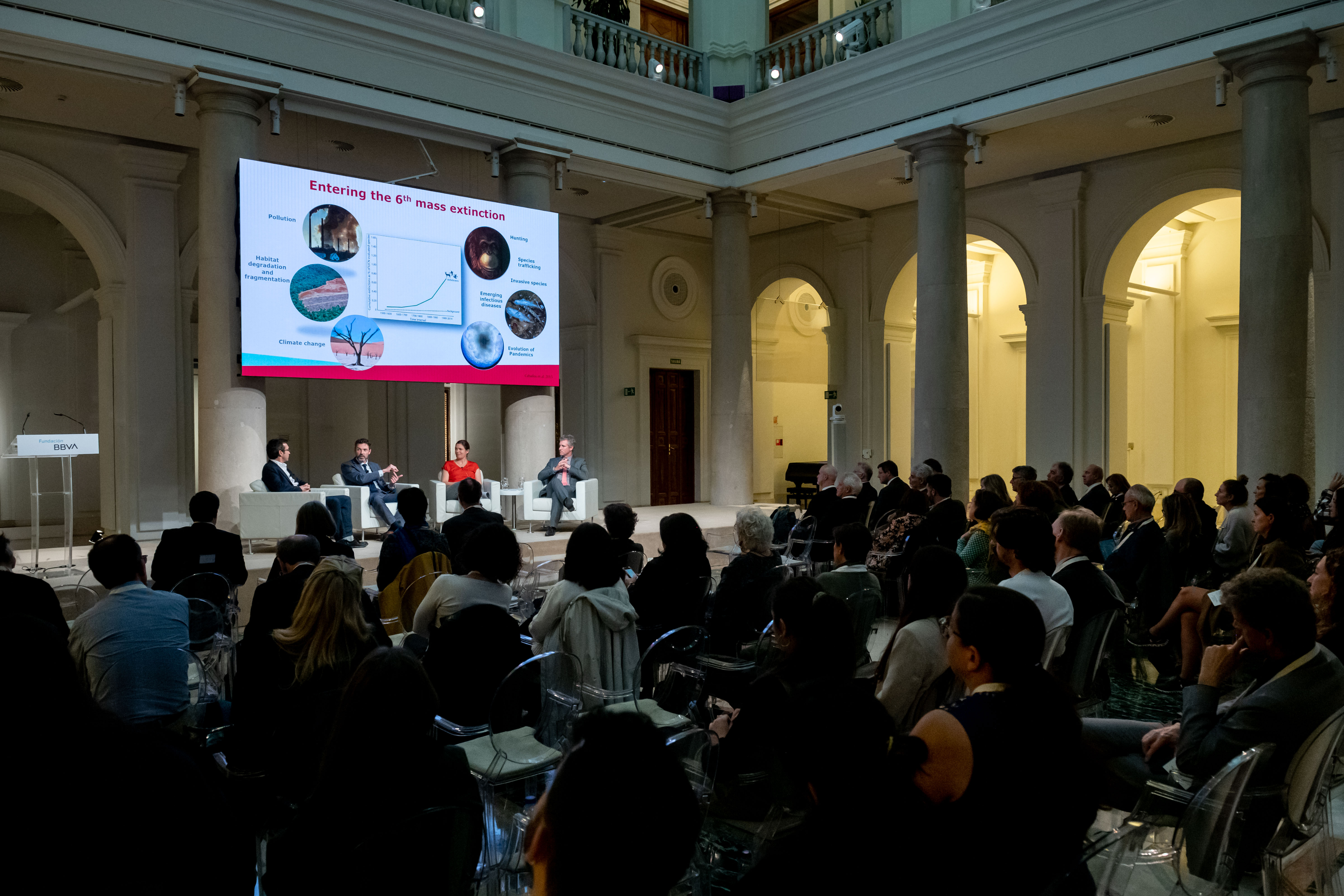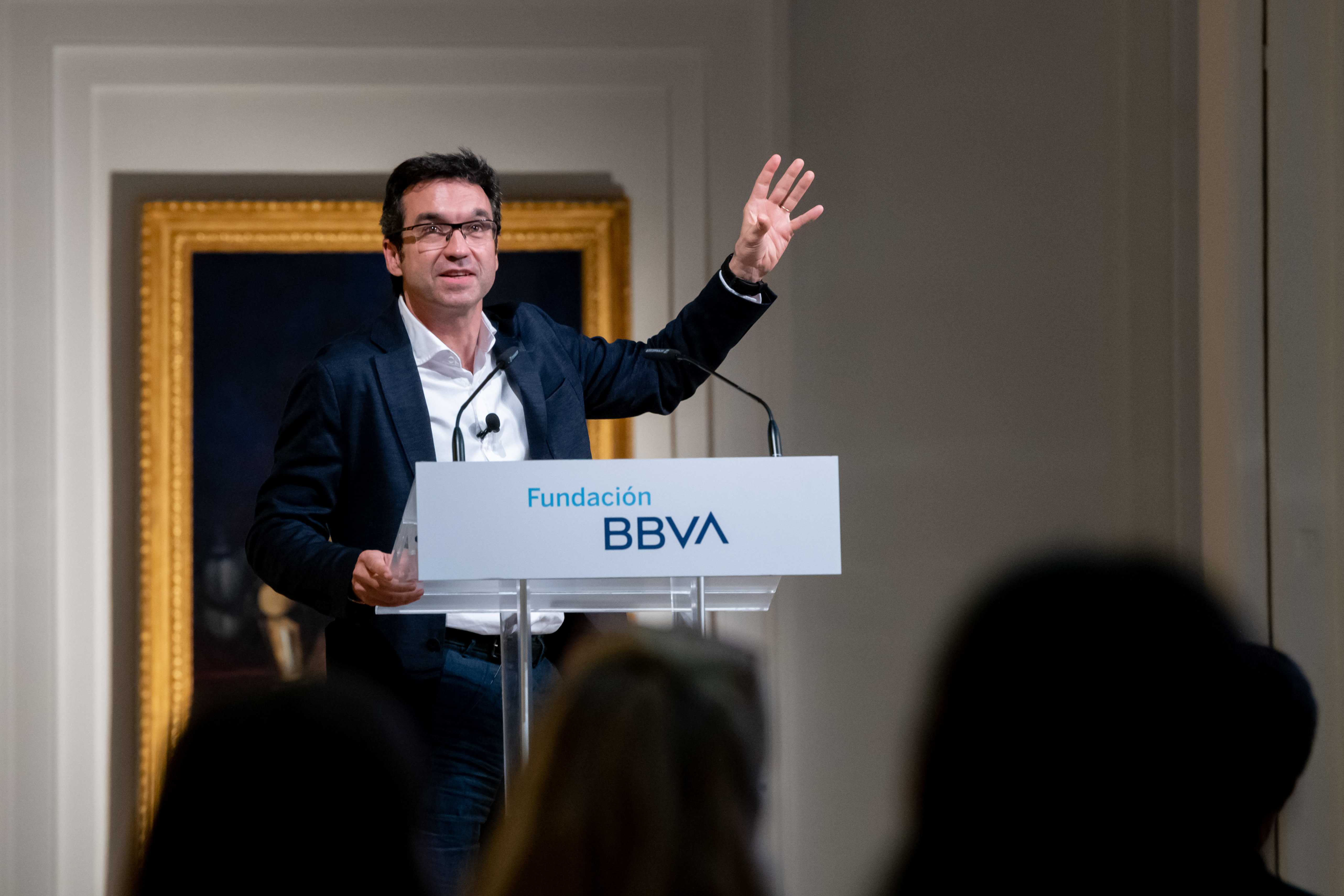Salvador Carranza participa al Fòrum internacional de directors de Museus de Ciències Naturals
Organitzat pel Museu Nacional de Ciències Naturals (MNCN-CSIC) i la Fundació BBVA, l'esdeveniment ha reunit els directors dels principals museus de ciències naturals del planeta.
Al llarg de les dues jornades, els representants han defensat la seva aposta per unificar digitalment les seves col·leccions i construir una gran xarxa global de coneixement davant dels reptes globals, com ara la pèrdua de biodiversitat i el canvi climàtic.
El director de l'IBE, Salvador Carranza, ha moderat una taula rodona sobre la crisi ambiental durant la trobada.

Els museus de ciències naturals poden i han de tenir un paper fonamental davant la crisi ambiental. No obstant això, per assolir aquest objectiu és imprescindible que uneixin les seves forces per construir una gran xarxa global de coneixement sobre la biodiversitat i el canvi climàtic: una sola base de dades que unifiqui digitalment tota la informació continguda a les seves col·leccions per posar-la a disposició de la comunitat científica. Aquesta és la principal conclusió del primer fòrum internacional que ha reunit en una mateixa ciutat els directors d'alguns dels museus de ciències naturals més importants tant d'Europa com dels Estats Units. La trobada –organitzada pel Museu Nacional de Ciències Naturals (MNCN-CSIC) amb motiu del seu 250è aniversari, en col·laboració amb la Fundació BBVA – ha abordat els majors reptes que comparteixen avui aquests centres al llarg de dues jornades de conferències i taules rodones.
"Els museus són una eina molt útil per afrontar l'amenaça doble de l'escalfament global i la sisena extinció massiva, a través de les seves tres missions fonamentals: la investigació, la preservació de les seves col·leccions i la comunicació del coneixement científic a la societat", va explicar. Kirk Johnson, director del Museu Nacional Smithsonian d'Història Natural, a Washington DC, durant la conferència que va pronunciar a la seu madrilenya de la Fundació BBVA.
"Abans treballàvem de manera aïllada, però avui necessitem un esforç global per digitalitzar les nostres col·leccions, que representen tot allò que la humanitat ha recopilat al llarg de centenars d'anys per comprendre el món natural".
Johnson va ressaltar en la seva ponència el "desafiament i l'oportunitat" que representa la ciència del Big Data per a les col·leccions dels museus de ciències naturals: una estratègia que permetrà unificar les dades per analitzar, per exemple, les distribucions d'espècies i l'impacte de la pressió humana sobre elles a tots els ecosistemes. "La cooperació global és crucial", va recalcar, "és imprescindible que pensem en termes de la nostra pertinença al planeta, en comptes dels nostres països individuals".
Un “bessó digital” per a cada mostra de fauna i flora
En aquesta mateixa línia, el director del museu de Leiden (Països Baixos), Edwin Van Huis, va presentar durant el fòrum els objectius de DiSSCo ( Distributed System of Scientific Collections ), un projecte que, sota el seu lideratge, ja està treballant per desenvolupar un únic portal d'Internet on es podrien consultar les dades sobre qualsevol espècimen a les col·leccions científiques dels museus. “La nostra idea és generar un 'bessó digital' de cada exemplar a les col·leccions dels museus, perquè la informació sobre qualsevol espècimen es trobi a disposició de la comunitat científica internacional”, va explicar Van Huis durant la seva intervenció a la Fundació BBVA.
Per la seva banda, Gonzalo Giribet, director del Museu de Zoologia Comparada de la Universitat de Harvard, va ressaltar que les col·leccions emmagatzemades al llarg de fins a 250 anys en aquests centres representen “un recurs biològic incomparable” per estudiar i comprendre “allò que ha passat amb les diferents poblacions d'animals o plantes durant tot aquest temps”. Es tracta d'una eina fonamental "no només per entendre què ha passat, sinó també per predir què podria passar i per tant buscar un remei per a la desaparició d'espècies i l'impacte de l'escalfament global".
Per motius històrics, els museus de ciències naturals dels diferents països han anat recopilant col·leccions de mostres provinents de diverses regions del planeta, vinculades als seus antics imperis. Però la riquesa única de cada col·lecció “es complementa perfectament amb la d'altres països” en paraules de Rafael Zardoya, director del Museu Nacional de Ciències Naturals, “i això fa que, units, puguem abastar tota aquesta realitat dels canvis que estan passant a nivell global, per determinar estadísticament com s'està produint la sisena extinció massiva i idear estratègies per aturar-la”.
Per això, Zardoya també va insistir en la necessitat d'avançar cap a “el somni de crear un gran museu global connectat en xarxa”, com “l'única manera eficaç de respondre al gran repte de la crisi ambiental”.
Convertir els ciutadans en “defensors del planeta”
Més enllà de l'indubtable valor científic que representen les històriques col·leccions dels museus per als investigadors de tot el món, el fòrum de directors també ha posat al focus la seva altra gran missió: la difusió del millor coneixement per conscienciar i sensibilitzar la societat sobre la degradació de la naturalesa.
Per exemplificar el gran potencial que poden tenir els museus a l'hora d'anticipar-se al futur i comunicar-ho al públic, Kirk Johnson va relatar com el maig del 2018, un any i mig abans de l'arribada del Covid-19, l' Smithsonian va inaugurar una exposició titulada Epidèmies en un món connectat : “Desconeixíem quan arribaria la pandèmia, però sabíem que abans o després passaria. Això demostra com la ciència pot preveure el futur i ajudar les persones a pensar sobre el món on viuen”. De la mateixa manera, en difondre els informes científics sobre el previsible impacte del canvi climàtic, el director del museu de la capital nord-americana va ressaltar que els museus poden conscienciar la societat sobre els riscos ambientals que encara estem a temps de prevenir.
Preveure el futur i connectar les persones amb la natura

Salvador Carranza, director de l'IBE, va ser l'encarregat de moderar la taula rodona centrada en el paper dels museus davant de la crisi ambiental. Durant la sessió, els directors participants van ressaltar com la societat confia en l'autoritat dels museus com a fonts acreditades d'informació, i per tant a través de les seves exposicions poden influir de manera molt positiva sobre les actituds i el comportament dels ciutadans davant dels reptes del canvi climàtic i el col·lapse de la biodiversitat.
"A Suècia, un estudi d'opinió pública va revelar que els museus eren institucions on la societat confia, molt per sobre de la classe política", va assenyalar Lisa Mansson, directora del museu d'Estocolm.
"Tenim la gran responsabilitat d'aprofitar la confiança pública que dipositen els ciutadans als museus per afrontar la crisi ambiental", va declarar Peter Kjaegaard, director del museu de Copenhaguen. “La nostra missió és difondre coneixement perquè les persones prenguin decisions informades, incloent per descomptat els polítics que han de prendre decisions basades en la ciència. Per aconseguir-ho, és imprescindible recórrer a narratives atractives sobre espècies icòniques, com l'ós polar, que connectin emocionalment les persones a la natura i els impulsin a voler preservar-la”.
Més informació sobre la trobada:
https://www.biophilia-fbbva.es/noticias/mncn-fundacion-bbva-acogen-primer-foro-internacional-directores-museos-ciencias-naturales/
https://www.mncn.csic.es/es/Comunicaci%C3%B3n/el-mncn-celebra-el-primer-foro-internacional-de-directores-de-museos-de-todo-el-mundo
